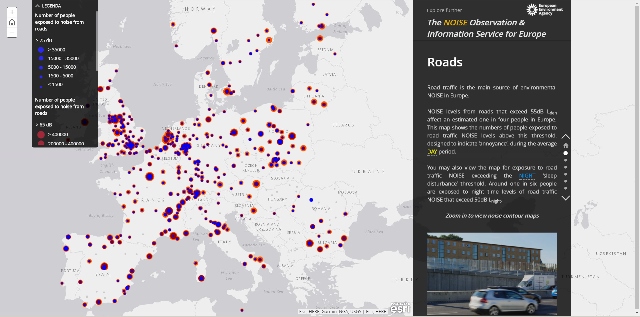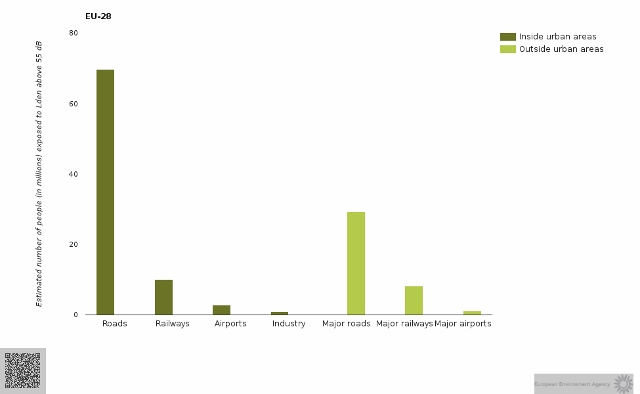Noise Mapping in the EU: State of Art and 2018 Challenges
By Gaetano Licitra, Environmental Protection Agency of Tuscany Region
Policy Framework
During the last two decades, a coordinated EU policy on noise has been developed. The 6th Environment Action Programme EAP (2002–2012) strengthened the concept of a knowledge-based approach to policymaking and proposed that the Commission would adopt and implement a directive on environmental noise—the Directive 2002/49/EC (the Environmental Noise Directive—END).
The Directive applies to noise that humans are exposed to, particularly in built-up areas, in public parks or other quiet areas in agglomerations or open country, near schools, hospitals, and other noise-sensitive buildings and areas. It requires member states (MS) to prepare and publish noise maps and noise management action plans for agglomerations, major roads, major railways, and major airports every five years. END avoids setting limits or target values and prescribing the measures to be included in the action plans, leaving those issues at the discretion of the competent MS authorities.
END, however, obliges the European Commission to adapt its Annexes I, II, and III to technical and scientific progress, notably to establish common noise assessment methods (Annex II) and methods for assessing harmful effects of noise by means of dose-effect relations (Annex III). While work on the latter is still ongoing, the former has recently been finalized, producing a new common method called CNOSSOS-EU for roads, railways, and industries, and confirming ECAC-29 as airport noise standard. In particular, the directive 2015/996 of the European Parliament and of the Council establishes common noise assessment methods according to Directive 2002/49/EC, enforcing MS to adopt the methods before December 31, 2018.
Moreover, the Commission identified the END as one of the regulations “to be evaluated with a focus on regulatory fitness” in the context of the Regulatory Fitness and Performance initiative (REFIT) and the Better Regulation program of the European Commission.[1] This evaluation covered all current provisions of the Directive, and addressed questions relating to effectiveness, efficiency, coherence, relevance, and EU added value.
It has also been evaluated that END has low administrative costs per citizen: € 0.15 for noise maps and € 0.03 for action plans. Cost-benefit analysis performed after the implementation of action plans also showed the Directive was efficient, with a favorable cost-benefit ratio of 1:29.
However, the Directive does not fully exploit its potential EU added value due to delays in implementation. It has been shown that the Directive is generally fit for its purpose, but requires a more meticulous execution. In fact, only about 80% of expected maps and less than 50% of action plans have been completed. In order to enhance its implementation, the European Commission organized a conference on “Noise in Europe” in April 2017[2] in order to involve stakeholders. Together with MS, stakeholders showed a general support on setting and periodically revising technologically feasible progressive targets.
However, an agreement on strict EU limits was not reached. According to some MS, this decision should be taken at the local level, and in any case they should mirror WHO-recommended levels to protect human health.
The New Common Method CNOSSOS-EU
The development of the CNOSSOS‐EU methodological framework involved European Commission services, EEA, EASA, WHO‐Europe, and almost 150 noise experts during the period from 2009 to 2012, fostering dialogue between the stakeholders involved, and enabling them to liaise and perform their activities synergistically under a joint collaborative framework.[3]
The method was first available as a point-to-point calculation tool and was tested in several studies. Only recently, the method was implemented in commercial software. However, these implementations are still under a test phase and might be revised before the mapping round foreseen in 2021.
In fact, first results highlighted some critical issues about CNOSSOS. First of all, a conversion of available data for vehicle categories must be performed for CNOSSOS, since they differ from previous categorizations. The new opportunity of mapping more vehicle categories should be taken using relevant traffic data. The solution proposed by the guideline, that is, to equally split heavy vehicles, is not the best solution, as it leads to an important mapping uncertainty. Secondly, it has been shown that the new formulation for absorption and diffraction leads to relevant differences with previous interim models.[4]
Finally, it seems that the CNOSSOS model estimates lower road traffic noise than previous models.[5] This might be relevant especially for health studies that require a correct noise estimation performed via calibrated maps.
Communication and Research Projects
Maps and plans are available on both a local website, in order to involve the public, and on the European Environment Agency’s ReportNet system. This allows comparison of actions and provides information about population exposure in the EU. Although different methods have been used to map noise, the interactive noise contour map increases awareness about noise and its potential effects (see figure 1).

Figure 1. Noise Observation and Information Service for Europe (http://noise.eea.europa.eu/)
According to recent exposure data from the European Environment Agency (EEA), more than 100 million European citizens are affected by high noise levels, which negatively impacts human health. In addition, many people are also exposed to railway, aircraft, and industrial noise, particularly in towns and cities[6] (see figure 2).

Figure 2. Estimated Number of People in the EU Exposed to High Daily Average Noise Levels, 2012
The END not only led to an increased awareness on noise issues, but also supported the development of several research projects partially funded by the EU itself, contributing to the improvement of environmental noise policies, helping local administrations on dealing with noise problems, and supporting urban sound plans.[7]
Generally, noise research projects aim at communicating noise issues efficiently, harmonizing methods, testing mitigation solutions, and evaluating health exposure.
A recent research project has also collected all pre- and post-actions studies in order to understand the contribution of specific actions to health improvement. The available evidence shows that transport noise interventions change health outcomes reported by those who experience the intervention, regardless of the source, outcome, or intervention type.[8]
Conclusions
EU member states are at a turning point. The opportunity to set up a common database of noise exposure based on common methods should be seized on time. Member states should be ready to implement the next mapping round, test the new methodology, and be aware of the framework already established. Although some issues have not been solved yet, guidance is available and the importance to implement the END has been shown. Positive health outcomes have been found after actions were taken. It is time to enhance health studies based on mapping data in order to increase awareness on noise issues. The new methods should be able to provide a common framework for health evaluations, paving the way for transnational studies. However, the challenge of establishing minimum requirements for maps to be used in health studies, both in terms of input data accuracy and output detail, remains.
Notes
[1] http://ec.europa.eu/transparency/regdoc/rep/10102/2016/EN/SWD-2016-454-F1-EN-MAIN-PART-1.PDF
[2] https://ec.europa.eu/info/events/noise-europe-2017-apr-24_en
[3] CNOSSOS EU http://139.191.1.188/
[4] F. Bertellino, P. Cicoira, F. Gerola, M. Clementel, P. Scaramuzza, and M. Nardelli, “Noise Mapping of Agglomerations: A Comparison of Interim Standards vs. New CNOSSOS-EU Method in a Real Case Study” (InterNOISE proceedings, Hamburg, 2016).
[5] D. W. Morley, K. de Hoogh, D. Fecht, F. Fabbri, M. Bell, P. S. Goodman, P. Elliott, S. Hodgson, A. L. Hansell, J. Gulliver, “International Scale Implementation of the CNOSSOS-EU Road Traffic Noise Prediction Model for Epidemiological Studies,” Environmental Pollution 206 (November 2015): 332–341, https://doi.org/10.1016/j.envpol.2015.07.031.
[6] European Environment Agency, Noise in Europe 2014, EEA Report No 10/2014, http://www.eea.europa.eu/publications/noise-in-europe-2014.
[7] Sonia Alves, Joachim Scheuren, and Beate Altreuther, “Review of Recent EU Funded Research Projects from the Perspective of Urban Sound Planning: Do the Results Cope with the Needs of Europe’s Noise Policy?” Noise Mapping 3, no. 1 (2016), https://doi.org/10.1515/noise-2016-0007.
[8] A. L. Brown, and I. van Kamp, “WHO Environmental Noise Guidelines for the European Region: A Systematic Review of Transport Noise Interventions and Their Impacts on Health,” International Journal of Environmental Research and Public Health 14, no. 8 (August 2017): 873, https://dx.doi.org/10.3390%2Fijerph14080873.


